As businesses grow, it becomes harder to keep things personal with customers. Yet personalization is more important than ever — it's not just a way to make customers feel valued, but a way to create better customer experiences and reduce service effort. Done right, personalization ensures customers get exactly the solutions and answers they need without additional hassle, strengthening trust and making interactions more efficient.
Why Personalization Matters
Personalization transforms one-size-fits-all approaches into something targeted and relevant. It boosts customer trust by showing you understand their unique needs, and it reduces service effort by preemptively addressing customer questions and needs.
But as businesses scale, personalization gets tricky. Growing audiences, diverse preferences, and mountains of data can overwhelm even the best teams. Let's explore the challenges and how to tackle them.
The Challenges of Scaling Personalization
1. Outdated Technology
Many businesses start with simple tools that work fine when the customer base is small. But as the audience grows, these systems struggle to keep up, leading to inconsistent experiences.
Example: A fitness app that initially offers customized workout plans falters as its user base expands. Data syncing issues across devices result in irrelevant suggestions, frustrating users who expect seamless, personalized answers to their fitness needs.
Solution: Upgrade to robust, scalable technology that can handle real-time updates and maintain consistency across all platforms.
2. Diverse Customer Preferences
What works for one group might completely miss the mark for another. A skincare brand expanding into new regions might recommend products without considering local climates. Heavy moisturizers for humid areas? Customers won't just ignore those suggestions — they might start doubting the brand altogether.
Solution: Adapt strategies to fit the unique needs of different customer segments, using data to tailor offerings and provide solutions that are relevant and practical.
3. Data Overload
Growth brings an avalanche of customer information, from browsing behavior to purchase history. Too much data without proper analysis can overwhelm your systems.
Example: An online bookstore recommends cookbooks to a mystery fan because it can't effectively process and prioritize relevant data.
Solution: Invest in smarter analytics tools to process data efficiently, delivering insights that make it easier to answer customer needs quickly and accurately.
How Personalization Reduces Effort and Improves Experiences
Personalization goes beyond creating a great customer experience — it can significantly reduce the effort required from both your customers and your service teams. By offering tailored answers and preemptive solutions, you can:
- Minimize Customer Service Inquiries: When customers receive exactly what they need, whether it's a product recommendation, troubleshooting help, or personalized advice, they're less likely to need further assistance.
- Streamline Customer Interactions: Personalized responses save customers time and frustration by cutting out irrelevant information.
- Ease the Load on Service Teams: With fewer generic questions and clearer customer expectations, support teams can focus on more complex issues.
For example, a well-personalized FAQ or chatbot can anticipate the most likely questions a customer might ask and offer the right solution without human intervention. This improves efficiency for everyone involved.
Strategies to Keep Personalization Strong
Keeping personalization effective as your business grows requires a thoughtful approach. These strategies will help ensure that personalization remains a cornerstone of your customer experience.
1. Upgrade Your Technology
Invest in systems that are built to scale. AI-powered tools, real-time data platforms, and advanced CRM systems can help you analyze customer behavior quickly and deliver timely, personalized responses. Make sure your technology stack is integrated, enabling seamless data flow across departments like marketing, sales, and support. This prevents the disconnects that frustrate customers and ensures service requests are resolved faster.
2. Focus on Data Quality
Collecting data is easy, but ensuring it's accurate and usable is a bigger challenge. Regularly audit and clean your customer data to remove duplicates, outdated information, or irrelevant details. High-quality data allows you to preemptively address customer needs, reducing the likelihood they'll need to ask for help.
3. Understand and Segment Your Audience
Go deeper than surface-level demographics. Behavioral data — like browsing habits, purchase history, and engagement patterns — offers powerful insights into customer needs and preferences. Use this information to create detailed customer segments and craft solutions that resonate with specific groups. For example, segment your audience by climate, lifestyle, or past interactions to deliver solutions that solve their unique problems.
4. Automate for Efficiency
Personalization at scale isn't possible without automation. Automated systems can send tailored messages, update recommendations, and handle repetitive tasks like customer follow-ups. These tools allow you to maintain the personal touch across a large audience without requiring constant manual effort. For instance, an automated chatbot can answer common customer questions based on their profile or recent activity, reducing the need for live support.
5. Use Feedback to Adapt
Personalization is not a one-and-done process. As your customer base grows and evolves, so should your personalization efforts. Actively seek feedback through surveys, reviews, and social media interactions to understand how well your strategies are working. Analyze what's resonating, what's falling flat, and where you can improve. Use this information to refine your messaging, improve recommendations, and ensure your solutions remain relevant to customer needs.
Making Personalization Work
By investing in the right tools, focusing on your audience, and adapting to their needs, personalization becomes more than a strategy — it's a powerful way to create seamless, efficient, and meaningful customer experiences. When done right, personalization transforms your brand into a trusted partner that customers rely on, time and time again.
